Prevalence and Factors Associated with Working Equid Lameness in Low- and Middle-Income Countries: A Systematic Review and Meta-Analysis
Abstract
Simple Summary
Abstract
1. Introduction
2. Materials and Methods
2.1. Search Strategy
- (1)
- (equid* OR horse* OR equine OR donkey* OR pony OR ponies OR mule OR mules)AND(working OR cart OR draft OR draught OR traction OR carriage OR caleche OR “horse drawn” OR cidomo)AND(lameness OR “gait abnormalit*” OR “gait irregular*” OR orthop* OR musculoskeletal OR injur* OR welfare)
- (2)
- (equid* OR horse* OR equine OR donkey* OR pony OR ponies OR mule OR mules) (working OR cart OR draft OR draught OR traction OR carriage OR caleche OR “horse drawn” OR cidomo) (lameness)
2.2. Article Screening and Eligibility Criteria
- The topic of interest met;
- Available in full text;
- Original research; and
- Available in English, French, Spanish, or Portuguese.
- Study meets one or more of the outcomes of interest (prevalence and/or incidence and/or factors associated with lameness, gait abnormality, or gait irregularity); and
- Primary empirical and secondary research, including cohort, case-control, cross-sectional studies, other observational studies, and retrospective data reviews.
2.3. Data Management and Extraction
2.4. Study Validity and Risk of Bias Assessment
2.5. Statistical Analysis
3. Results
3.1. Systematic Review of Studies Investigating Working Equid Lameness in LMICs
3.2. Study Populations
3.3. Study Focus and Study Arms
3.4. Detection and Definition of Lameness Outcomes
3.5. Prevalence of Lameness-Related Outcomes
3.6. Study Factors for Lameness-Related Outcomes
3.7. Meta-Analysis of Study Factors
3.8. Studies Included for Qualitative Assessment Only
4. Discussion
5. Conclusions
Supplementary Materials
Author Contributions
Funding
Data Availability Statement
Acknowledgments
Conflicts of Interest
References
- FAO. FAOSTAT, Production Data, Live Animals. In Food and Agriculture Data for over 245 Countries and Territories; Food and Agriculture Organization of the United Nations: Rome, Italy, 2019. [Google Scholar]
- Sturgeon, B. Working Animals–One Health, One Welfare. In One Welfare in Practice; CRC Press: Boca Raton, FL, USA, 2021; pp. 279–317. [Google Scholar]
- Maggs, H.C.; Ainslie, A.; Bennett, R.M. Donkey Ownership Provides a Range of Income Benefits to the Livelihoods of Rural Households in Northern Ghana. Animals 2021, 11, 3154. [Google Scholar] [CrossRef] [PubMed]
- Geiger, M.; Hockenhull, J.; Buller, H.; Tefera Engida, G.; Getachew, M.; Burden, F.A.; Whay, H.R. Understanding the attitudes of communities to the social, economic, and cultural importance of working donkeys in rural, peri-urban, and urban areas of Ethiopia. Front. Vet. Sci. 2020, 7, 60. [Google Scholar] [CrossRef] [PubMed]
- Gelaye, A.; Fesseha, H. Assessment of Socio-economic Importance and Major Constraints of Working Equines in and around Debre Berhan Town, Central Ethiopia. Vet. Med. Open J. 2020, 5, 30–38. [Google Scholar] [CrossRef]
- Brooke. Invisible Workers Report; The Brooke: London, UK, 2015. [Google Scholar]
- Dyson, S. Lameness and poor performance in the sport horse: Dressage, show jumping and horse trials. J. Equine Vet. Sci. 2002, 4, 145–150. [Google Scholar] [CrossRef]
- Ireland, J.; Wylie, C.; Collins, S.; Verheyen, K.; Newton, J. Preventive health care and owner-reported disease prevalence of horses and ponies in Great Britain. Res. Vet. Sci. 2013, 95, 418–424. [Google Scholar] [CrossRef]
- Jönsson, L.; Roepstorff, L.; Egenvall, A.; Näsholm, A.; Dalin, G.; Philipsson, J. Prevalence of clinical findings at examinations of young Swedish warmblood ridinghorses. Acta Vet. Scand. 2013, 55, 34. [Google Scholar] [CrossRef]
- Pollard, D.; Wylie, C.; Newton, J.; Verheyen, K. Factors associated with euthanasia in horses and ponies enrolled in a laminitis cohort study in Great Britain. Prev. Vet. Med. 2020, 174, 104833. [Google Scholar] [CrossRef]
- Broster, C.E.; Burn, C.C.; Barr, A.R.S.; Whay, H.R. The range and prevalence of pathological abnormalities associated with lameness in working horses from developing countries. Equine Vet. J. 2009, 41, 474–481. [Google Scholar] [CrossRef]
- Reix, C.E.; Burn, C.C.; Pritchard, J.C.; Barr, A.R.S.; Whay, H.R. The range and prevalence of clinical signs and conformation associated with lameness in working draught donkeys in Pakistan. Equine Vet. J. 2014, 46, 771–777. [Google Scholar] [CrossRef]
- King, S.R.; Puerto Nájera, J.L.; Sierra Lira, E.M.; Erales Villamil, J.A.; Bolio González, M.E.; Brown, M.P.; Hernández de Anda, J.A. Prevalence of lameness in carriage horses in Yucatan, Mexico. J. Appl. Res. Vet. Med. 2009, 7, 206. [Google Scholar]
- Ali, A.; Solomon, O.; Tewodros, T.; Zambriski, J.A. The prevalence of lameness and associated risk factors in cart mules in Bahir Dar, Ethiopia. Trop. Anim. Health Prod. 2016, 48, 1483–1489. [Google Scholar] [CrossRef] [PubMed]
- Kiros, A.; Gezahegn, M.; Aylate, A. A cross sectional study on risk factors associated with lameness of working donkeys in and around Hawassa, Ethiopia. J. Anim. Health Prod 2016, 4, 87–94. [Google Scholar] [CrossRef]
- Bazezew, M.; Chanie, M.; Tesfaye, T.; Kassa, A.; Mekonnen, B.; Wagaw, N. Lameness and associated risk factors in Cart Mules in Northwestern Ethiopia. Glob. Vet. 2014, 12, 869–877. [Google Scholar]
- Pritchard, J.; Lindberg, A.; Main, D.; Whay, H. Assessment of the welfare of working horses, mules and donkeys, using health and behaviour parameters. Prev. Vet. Med. 2005, 69, 265–283. [Google Scholar] [CrossRef]
- Morgan, R. The epidemiology of lameness in working donkeys in Addis Ababa and the central Oromia region of Ethiopia: A comparative study of urban and rural donkey populations. In Proceedings of the Fifth International Colloquium on Working Equines, Addis Ababa, Ethiopia, 30 October–2 November 2006; pp. 99–106. [Google Scholar]
- Rahman, A.; Reed, K. The management and welfare of working animals: Identifying problems, seeking solutions and anticipating the future. Rev. Sci. Tech. (Int. Off. Epizoot.) 2014, 33, 197–202. [Google Scholar] [CrossRef]
- The World by Income and Region [Internet]. The World Bank. [Cited 2021]. Available online: https://datatopics.worldbank.org/world-development-indicators/the-world-by-income-and-region.html (accessed on 12 October 2021).
- EndNote20; Clarivate: Philadelphia, PA, USA, 2013.
- Covidence Systematic Review Software, Veritas Health Innovation, Melbourne, Australia. Available online: www.covidence.org (accessed on 26 July 2021).
- Norris, S.L.; Kubasiewicz, L.M.; Watson, T.L.; Little, H.A.; Yadav, A.K.; Thapa, S.; Raw, Z.; Burden, F.A. A new framework for assessing equid welfare: A case study of working equids in Nepalese brick kilns. Animals 2020, 10, 1074. [Google Scholar] [CrossRef]
- Burn, C.C.; Dennison, T.L.; Whay, H.R. Environmental and demographic risk factors for poor welfare in working horses, donkeys and mules in developing countries. Vet. J. 2010, 186, 385–392. [Google Scholar] [CrossRef]
- Hoy, D.; Brooks, P.; Woolf, A.; Blyth, F.; March, L.; Bain, C.; Baker, P.; Smith, E.; Buchbinder, R. Assessing risk of bias in prevalence studies: Modification of an existing tool and evidence of interrater agreement. J. Clin. Epidemiol. 2012, 65, 934–939. [Google Scholar] [CrossRef]
- R Core Team. R: A Language and Environment for Statistical Computing; R Foundation for Statistical Computing: Vienna, Austria, 2021. [Google Scholar]
- Schwarzer, G.; Carpenter, J.R.; Rücker, G. Meta-Analysis with R; Springer: Cham, Switzerland, 2015; Volume 4784. [Google Scholar]
- Harrer, M.; Cuijpers, P.; Furukawa, T.A.; Ebert, D.D. Doing Meta-Analysis with R: A Hands-On Guide; Chapman and Hall: London, UK; CRC: Boca Raton, FL, USA, 2021. [Google Scholar]
- Viechtbauer, W. Bias and efficiency of meta-analytic variance estimators in the random-effects model. J. Educ. Behav. Stat. 2005, 30, 261–293. [Google Scholar] [CrossRef]
- Higgins, J.P.; Thompson, S.G. Quantifying heterogeneity in a meta-analysis. Stat. Med. 2002, 21, 1539–1558. [Google Scholar] [CrossRef]
- Namangale, T.J.; Bakili, O.; Tanganyika, J. An assessment of donkeys’ welfare using physical and emotional parameters: A case of Mkwinda EPA, Bunda area, Lilongwe, Malawi. Tanzan. Vet. J. 2017, 35, 188–195. [Google Scholar]
- Baujat, B.; Mahé, C.; Pignon, J.P.; Hill, C. A graphical method for exploring heterogeneity in meta-analyses: Application to a meta-analysis of 65 trials. Stat. Med. 2002, 21, 2641–2652. [Google Scholar] [CrossRef] [PubMed]
- Viechtbauer, W.; Cheung, M.W.L. Outlier and influence diagnostics for meta-analysis. Res. Synth. Methods 2010, 1, 112–125. [Google Scholar] [CrossRef] [PubMed]
- Haddy, E.; Burden, F.; Prado-Ortiz, O.; Zappi, H.; Raw, Z.; Proops, L. Comparison of working equid welfare across three regions of Mexico. Equine Vet. J. 2021, 53, 763–770. [Google Scholar] [CrossRef]
- Stroup, D.F.; Berlin, J.A.; Morton, S.C.; Olkin, I.; Williamson, G.D.; Rennie, D.; Moher, D.; Becker, B.J.; Sipe, T.A.; Thacker, S.B. Meta-analysis of observational studies in epidemiology: A proposal for reporting. Meta-analysis Of Observational Studies in Epidemiology (MOOSE) group. JAMA 2000, 283, 2008–2012. [Google Scholar] [CrossRef]
- Moher, D.; Shamseer, L.; Clarke, M.; Ghersi, D.; Liberati, A.; Petticrew, M.; Shekelle, P.; Stewart, L.A. Preferred reporting items for systematic review and meta-analysis protocols (PRISMA-P) 2015 statement. Syst. Rev. 2015, 4, 1–9. [Google Scholar] [CrossRef]
- Lorenz, M.; Aisch, G.; Kokkelink, D. Datawrapper: Create Charts and Maps [Software]. 2012. Available online: https://www.datawrapper.de/ (accessed on 22 March 2022).
- Watson, T.L.; Kubasiewicz, L.M.; Chamberlain, N.; Nye, C.; Raw, Z.; Burden, F.A. Cultural “Blind Spots”, Social Influence and the Welfare of Working Donkeys in Brick Kilns in Northern India. Front. Vet. Sci. 2020, 7, 214. [Google Scholar] [CrossRef]
- American Association of Equine Practitioners (AAEP). Guide for Veterinary Service and Judging of Equestrian Events; AAEP: Lexington, KY, USA, 1991. [Google Scholar]
- American Association of Equine Practitioners (AAEP). Lameness Exams: Evaluating the Lame Horse. Available online: https://aaep.org/issue/lameness-exams-evaluating-lame-horse (accessed on 24 May 2022).
- Galindo, F.; Aluja, A.d.; Cagigas, R.; Huerta, L.A.; Tadich, T.A. Application of the hands-on donkey tool for assessing the welfare of working equids at Tuliman, Mexico. J. Appl. Anim. Welf. Sci. 2018, 21, 93–100. [Google Scholar] [CrossRef]
- Raw, Z.; Rodrigues, J.B.; Rickards, K.; Ryding, J.; Norris, S.L.; Judge, A.; Kubasiewicz, L.M.; Watson, T.L.; Little, H.; Hart, B. Equid assessment, research and scoping (EARS): The development and implementation of a new equid welfare assessment and monitoring tool. Animals 2020, 10, 297. [Google Scholar] [CrossRef]
- Busschers, E.; Van Weeren, P. Use of the flexion test of the distal forelimb in the sound horse: Repeatability and effect of age, gender, weight, height and fetlock joint range of motion. J. Vet. Med. Ser. A 2001, 48, 413–427. [Google Scholar] [CrossRef]
- Ashinde, A.; Gashaw, A.; Abdela, N. Health and welfare status of donkeys in and around Hawassa town, Southern Ethiopia. J. Vet. Med. Anim. Health 2017, 9, 300–312. [Google Scholar]
- Alves, F.R.; Guerra, P.C.; Mariana, A.N.B.; Vulcano, L.C. Clinical and radiographic evaluation of bone diseases in the distal forelimb region of donkeys (Equus asinus) used in animal traction vehicles in São Luis, MA, Brazil. Rev. Educ. Contin. CRMV-SP. 2003, 6, 42–52. [Google Scholar]
- de Andrade, R.L.F.S.; Sobral, J.D.C.; da Silva, K.M.G. Clinical, hematological and parasitological evaluation in equines used for wagon traction in Aracajú City, SE, Brazil. Acta Vet. Bras. 2009, 3, 138–142. [Google Scholar]
- Solomon, A.; Fekadu, A.; Molla, B.; Sheferaw, D. The prevalence of foot related problems in working donkeys and its implication on the livelihood of donkey owners in Hawassa City, Southern Ethiopia. Int. J. Livest. Prod. 2019, 10, 86–93. [Google Scholar]
- Ayele, G.; Feseha, G.; Bojia, E.; Getachew, M.; Alemayehu, F.; Tesfaye, M.; Amare, B.; Dereje, N.; Chala, C.; Asefa, A.; et al. Principal Health Problems of Donkeys in Dugda Bora district of Ethiopia; The Donkey Sanctuary: Sidmouth, UK, 2007; pp. 162–168. [Google Scholar]
- Fekadu, A.; Teshome, H.; Worku, T. Epidemiology of lameness among cart pulling donkeys in Hawassa City Administration, Southern Ethiopia. Acad. J. Anim. Dis. 2015, 4, 52–59. [Google Scholar]
- Tesfaye, S.; Deressa, B.; Teshome, E. Study on the health and welfare of working donkeys in mirab abaya district, southern Ethiopia. Acad. J. Anim. Dis. 2016, 5, 40–52. [Google Scholar]
- Chaves, N.P.; Bezerra, D.C.; Guerra, P.C.; Pereira, H.d.M.; Santos, H.P.; Vulcano, L.C. Foot lesions in donkeys (Equus asinus) used in animal traction vehicles in the city of San Luiz, Maranhão. Ciência Anim. Bras. 2011, 12, 365–370. [Google Scholar]
- Daneil, G.; Asmare, A.A. Assesment on the welfare and its influence on the health of cart horses in Combolcha District, Ethiopia. Folia Vet. 2013, 57, 183–189. [Google Scholar]
- Tadesse, G. Health constraints of cart horses in the dry warm, sub-moist tepid and moist cool climatic zones of central Ethiopia. Ethiop. Vet. J. 2014, 18, 99–107. [Google Scholar]
- Gichure, M.; Onono, J.; Wahome, R.; Gathura, P. Assessment of phenotypic characteristics and work suitability for working donkeys in the central highlands in Kenya. Vet. Med. Int. 2020, 2020, 8816983. [Google Scholar] [CrossRef]
- Haddy, E.; Burden, F.; Fernando-Martinez, J.A.; Legaria-Ramirez, D.; Raw, Z.; Brown, J.; Kaminski, J. and Proops, L. Evaluation of long-term welfare initiatives on working equid welfare and social transmission of knowledge in Mexico. PLoS ONE 2021, 16, e0251002. [Google Scholar] [CrossRef] [PubMed]
- Leeb, C.; Henstridge, C.; Dewhurst, K.; Bazeley, K. Welfare assessment of working donkeys: Assessment of the impact of an animal healthcare project in West Kenya. Animal Welf. 2003, 12, 689–694. [Google Scholar]
- McLean, A.K.; Heleski, C.R.; Yokoyama, M.T.; Wang, W.; Doumbia, A.; Dembele, B. Improving working donkey (Equus asinus) welfare and management in Mali, West Africa. J. Vet. Behav. Clin. Appl. Res. 2012, 7, 123–134. [Google Scholar] [CrossRef]
- Menarim, B.; Fortini, G.; Alvarez, P.; Tadich, T.; Galecio, S. Clinical, Radiographic and Ultrasound Aspects of Lameness in Urban Draught Horses in Chile; The Brooke: London, UK, 2010; pp. 244–249. [Google Scholar]
- Amante, M.; Hunde, A.; Endebu, B.; Hirpa, E.; Mamo, B. Health and welfare assessment of working equine in and around Nekemte town, east Wollega zone, Ethiopia. Am.-Eurasian J. Sci. Res. 2014, 9, 163–174. [Google Scholar]
- Pinsky, T.C.; Puja, I.K.; Aleri, J.; Hood, J.; Sasadara, M.M.; Collins, T. A pilot welfare assessment of working ponies on Gili Trawangan, Indonesia. Animals 2019, 9, 433. [Google Scholar] [CrossRef] [PubMed]
- Popescu, S.; Diugan, E.A.; Oros, D.; Borda, C. The Owners’ Assessment of Lameness in Working Horses. Lucrari Stiintifice; Universitatea de Stiinte Agricole a Banatului Timisoara, Medicina Veterinara: Timișoara, Romania, 2016; Volume 49, pp. 170–175. [Google Scholar]
- Reddy, R.D. Common ailments in working equines—A field study. Centaur 2005, 22, 22–25. [Google Scholar]
- Regan Nee Ashley, F.H.; Hockenhull, J.; Pritchard, J.C.; Waterman-Pearson, A.E.; Whay, H.R. Clinical abnormalities in working donkeys and their associations with behaviour. Vet. Rec. Open 2015, 2, e000105. [Google Scholar] [CrossRef]
- Rodrigues, J.B.; Sullivan, R.J.E.; Judge, A.; Norris, S.L.; Burden, F.A. Quantifying poor working equid welfare in Nepalese brick kilns using a welfare assessment tool. Vet. Rec. 2020, 187, 445. [Google Scholar] [CrossRef]
- Shelima, B.; Dinka, H.; Abelti, A.; Mume, T.; Geleta, T.; Chala, R. Major Constraints and Health Management of Carthorses in the Mid Rift Valley of Ethiopia; The Donkey Sanctuary: Sidmouth, UK, 2007; pp. 231–241. [Google Scholar]
- Fsahaye, S.; Kumar, N.; Kebede, E.; Abebe, N. Health and welfare assessment of working donkeys in and around Rama Town, Tigray, Ethiopia. Ethiop. Vet. J. 2018, 22, 26–39. [Google Scholar] [CrossRef]
- Herago, T.; Megersa, M.; Niguse, A.; Fayera, T. Assessment on working donkey welfare issue in Wolaita Soddo Zuria district, southern Ethiopia. Glob. Vet. 2015, 14, 867–875. [Google Scholar]
- Tanga, B.M.; Gebremeskel, A.K. The neglected welfare statue of working donkeys in Ethiopia: The case of Dale district in southern Ethiopia. J. Vet. Med. Anim. Health 2019, 11, 6–11. [Google Scholar]
- Upjohn, M.M.; Attwood, G.A.; Lerotholi, T.; Pfeiffer, D.U.; Verheyen, K.L.P. Quantitative versus qualitative approaches: A comparison of two research methods applied to identification of key health issues for working horses in Lesotho. Prev. Vet. Med. 2013, 108, 313–320. [Google Scholar] [CrossRef] [PubMed]
- Upjohn, M.M.; Shipton, K.; Pfeiffer, D.U.; Lerotholi, T.; Attwood, G.; Verheyen, K.L.P. Cross-sectional survey of owner knowledge and husbandry practices, tack and health issues affecting working horses in Lesotho. Equine Vet. J. 2012, 44, 310–318. [Google Scholar] [CrossRef] [PubMed]
- Usman, S.; Disassa, H.; Kabeta, T.; Zenebe, T.; Kebede, G. Health and welfare related assessment of working equine in and Around Batu Town, East Shoa, Central Ethiopia. Nat Sci. 2015, 13, 1–8. [Google Scholar]
- Biswas, P.; Dutt, T.; Patel, M.; Reena, K.; Bharti, P.K.; Sahu, S. Assessment of pack animal welfare in and around Bareilly city of India. Vet. World 2013, 6, 332–336. [Google Scholar] [CrossRef]
- Dennison, T.L.; Khan, G.S.; Khan, A.R.; Pritchard, J.C.; Whay, H.R. A Comparative Study of the Welfare of Equines Working in the Brick Kilns of Multan and Peshawar, Pakistan; The Donkey Sanctuary: Sidmouth, UK, 2007; pp. 153–160. [Google Scholar]
- Popescu, S.; Borda, C.; Diugan, E.A.; El-Mahdy, C.; Spinu, M.; Sandru, C.D. Human related indifference as a working horse welfare indicator. Bull. Univ. Agric. Sci. Vet. Med. Cluj-Napoca Vet. Med. 2014, 71, 174–181. [Google Scholar]
- Popescu, S.; Diugan, E.A. Welfare Assessment of Working Horses through the Use of Animal-Linked Parameters; Suranaree University of Technology: Nakhon Ratchasima, Thailand, 2011; pp. 635–639. [Google Scholar]
- Popescu, S.; Diugan, E.A. The relationship between the welfare quality and stress index in working and breeding horses. Res. Vet. Sci. 2017, 115, 442–450. [Google Scholar] [CrossRef]
- Popescu, S.; Diugan, E.A.; Spinu, M.; Sandru, C.D. Animal Linked Parameters in the Working Horses’ Welfare Assessment. Lucrari Stiintifice; Universitatea de Stiinte Agricole a Banatului Timisoara, Medicina Veterinara: Timișoara, Romania, 2012; Volume 45, pp. 124–132. [Google Scholar]
- Popescu, S.; Diugan, E.A. The relationship between behavioral and other welfare indicators of working horses. J. Equine. Vet. Sci. 2013, 33, 1–12. [Google Scholar] [CrossRef]
- Mekuria, S.; Mulachew, M.; Abebe, R. Management practices and welfare problems encountered on working equids in Hawassa town, Southern Ethiopia. J. Vet. Med. Anim. Health. 2013, 5, 243–250. [Google Scholar]
- Asfaw, H.; Tadesse, G. Economic Contribution of Cart Horses to the Livelihoods of Families in Gondar Town Ethiopia. Momona Ethiop. J. Sci. 2020, 12, 135–147. [Google Scholar] [CrossRef]
- Assefa, G.; Abera, B.; Nur, A.; Lemma, D.; Keno, L.; Eticha, E.; Chali, G.; Hussen, M. The major cause of lameness and associated risk factors in working donkey in and around Hawassa town, Ethiopia. J. Vet. Sci. Technol 2017, 8, 427. [Google Scholar] [CrossRef]
- Chala, C.; Bojia, E.; Feleke, G.; Alemayehu, F.; Zerihun, A.; Kassaye, A. Health and welfare problems of pack donkeys and cart horses in and around Holeta town, Walmara district, central Ethiopia. J. Vet. Med. Anim. Health 2019, 11, 17–25. [Google Scholar] [CrossRef][Green Version]
- Popescu, S.; Diugan, E.A.; Spinu, M. The interrelations of good welfare indicators assessed in working horses and their relationships with the type of work. Res. Vet. Sci. 2014, 96, 406–414. [Google Scholar] [CrossRef] [PubMed]
- Reix, C.E.; Dikshit, A.K.; Hockenhull, J.; Parker, R.M.A.; Anindo, B.; Burn, C.C.; Pritchard, J.C.; Whay, H.R. A two-year participatory intervention project with owners to reduce lameness and limb abnormalities in working horses in Jaipur, India. PLoS ONE 2015, 10, e0124342. [Google Scholar] [CrossRef]
- Sáez, M.; Escobar, A.; Tadich, T.A. Morphological characteristics and most frequent health constraints of urban draught horses attending a free healthcare programme in the south of Chile: A retrospective study (1997–2009). Livest. Res. Rural Dev. 2013, 25, 91. [Google Scholar]
- Schork, I.G.; Young, R.J. Rapid animal welfare assessment: An archaeological approach. Biol. Lett. 2014, 10, 20140390. [Google Scholar] [CrossRef]
- Schork, I.G.; de Azevedo, C.S.; Young, R.J. Personality, abnormal behaviour, and health: An evaluation of the welfare of police horses. PLoS ONE 2018, 13, e0202750. [Google Scholar] [CrossRef]
- Tadesse, D.; Asefa, Z.; Alemu, A.; Endebu, B.; Kassaye, A.; Fanta, A.; Chaburte, C. Identification of causes and associated risk factors for lameness in working donkeys in and around Bishoftu. J. Anim. Sci. Vet. Med. 2019, 4, 16–23. [Google Scholar] [CrossRef]
- Tewelde, F.; Reta, T.; Hagos, Y. A study on hoof abnormalities among working donkeys presented to veterinary clinics in and around Mekelle, Ethiopia. Ethiop. Vet. J. 2018, 22, 111–120. [Google Scholar] [CrossRef][Green Version]
- Varshney, M.; Tyagi, S.P.; Kaur, P. A study on the limb conformational defects in equine. Indian J. Vet. Surg. 2009, 30, 81–84. [Google Scholar]
- Robledo-Reyes, E.E.; Hernández-Gil, M.; Rojas-Hernández, S.; Camacho-Díaz, L.M.; Cipriano-Salazar, M.; Villa-Mancera, A.; Olivares-Pérez, J. Management and welfare of working equids in the Guerrero state. Ecosistemas Y Recur. Agropecu. 2020, 7. [Google Scholar] [CrossRef]
- Niraj, K.; Fisseha, K.K.; Shishay, N.; Hagos, Y. Welfare assessment of working donkeys in Mekelle city, Ethiopia. Glob. Vet. 2014, 12, 314–319. [Google Scholar]
- Molla, B.; Dembela, S.; Megersa, B.; Mekuria, W. The Welfare, Watering, Housing, Feeding and Working Management of Working Donkeys in and Around Hawassa City, Southern Ethiopia. J. Vet. Res. Anim. Husb. 2017, 2, 106. [Google Scholar]
- Weishaupt, M.A.; Wiestner, T.; Hogg, H.; Jordan, P.; Auer, J.A.; Barrey, E. Assessment of gait irregularities in the horse: Eye vs. gait analysis. Equine Vet. J. 2001, 33, 135–140. [Google Scholar] [CrossRef] [PubMed]
- Baxter, G.M. Adams and Stashak’s Lameness in Horses; John Wiley & Sons: Chichester, UK, 2011; pp. 28, 1242. [Google Scholar]
- Buchner, H.; Savelberg, H.; Schamhardt, H.; Barneveld, A. Head and trunk movement adaptations in horses with experimentally induced fore-or hindlimb lameness. Equine Vet. J. 1996, 28, 71–76. [Google Scholar] [CrossRef]
- Starke, S.D.; Oosterlinck, M. Reliability of equine visual lameness classification as a function of expertise, lameness severity and rater confidence. Vet. Rec. 2019, 184, 63. [Google Scholar] [CrossRef]
- Jarvis, N.; McKenzie, H.C. Nutritional considerations when dealing with an underweight adult or senior horse. Vet. Clin. Equine Pract. 2021, 37, 89–110. [Google Scholar] [CrossRef]
- Burden, F.A.; Bell, N. Donkey nutrition and malnutrition. Vet. Clin. Equine Pract. 2019, 35, 469–479. [Google Scholar] [CrossRef]
- Axelsson, M.; Björnsdottir, S.; Eksell, P.; Häggström, J.; Sigurdsson, H.; Carlsten, J. Risk factors associated with hindlimb lameness and degenerative joint disease in the distal tarsus of Icelandic horses. Equine Vet. J. 2001, 33, 84–90. [Google Scholar] [CrossRef]
- Parkes, R.S.; Newton, J.R.; Dyson, S.J. An investigation of risk factors for foot-related lameness in a United Kingdom referral population of horses. Vet. J. 2013, 196, 218–225. [Google Scholar] [CrossRef]
- Murray, R.C.; Walters, J.M.; Snart, H.; Dyson, S.J.; Parkin, T.D. Identification of risk factors for lameness in dressage horses. Vet. J. 2010, 184, 27–36. [Google Scholar] [CrossRef] [PubMed]
- Doumbia, A. Changing Attitudes in Mali, the Feeder Country for the Hide Trade. In Proceedings of the 6th Donkey Welfare Symposium, Davis, CA, USA, 3–5 November 2018; pp. 25–27. [Google Scholar]
- Tavassoli, M.; Dalir-Naghadeh, B.; Esmaeili-Sani, S. Prevalence of gastrointestinal parasites in working horses. Pol. J. Vet. Sci. 2010, 13, 319. [Google Scholar] [PubMed]
- Burn, C.C.; Dennison, T.L.; Whay, H.R. Relationships between behaviour and health in working horses, donkeys, and mules in developing countries. Appl. Anim. Behav. Sci. 2010, 126, 109–118. [Google Scholar] [CrossRef]
- Fureix, C.; Jego, P.; Henry, S.; Lansade, L.; Hausberger, M. Towards an ethological animal model of depression? A study on horses. PLoS ONE 2012, 7, e39280. [Google Scholar] [CrossRef]
- Menzies-Gow, N.J.; Wakeel, F.; Little, H.; Buil, J.; Rickards, K. Cross-sectional study to identify the prevalence of and factors associated with laminitis in UK donkeys. Equine Vet. J. 2021, 54, 757–765. [Google Scholar] [CrossRef]
- Pritchard, J.; Upjohn, M.; Hirson, T. Improving working equine welfare in ‘hard-win’ situations, where gains are difficult, expensive or marginal. PLoS ONE 2018, 13, e0191950. [Google Scholar] [CrossRef]
- Sargeant, J.M.; Brennan, M.L.; O’Connor, A.M. Levels of Evidence, Quality Assessment, and Risk of Bias: Evaluating the Internal Validity of Primary Research. Front. Vet. Sci. 2022, 9, 960957. [Google Scholar] [CrossRef]
- Burden, F.A.; du Toit, N.; Hernandez-Gil, M.; Prado-Ortiz, O.; Trawford, A.F. Selected health and management issues facing working donkeys presented for veterinary treatment in rural Mexico: Some possible risk factors and potential intervention strategies. Trop. Anim. Health Prod. 2010, 42, 597–605. [Google Scholar]
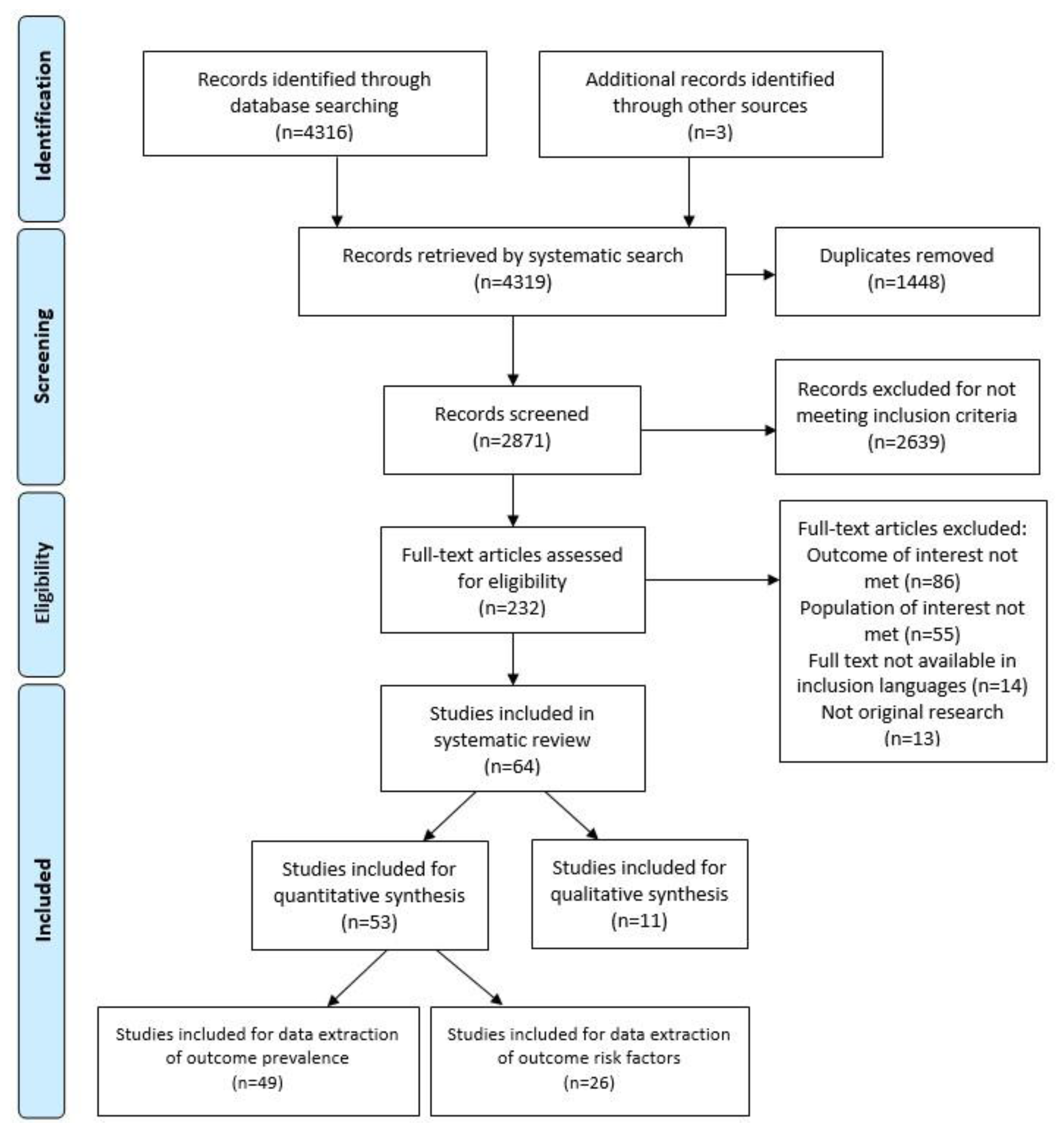
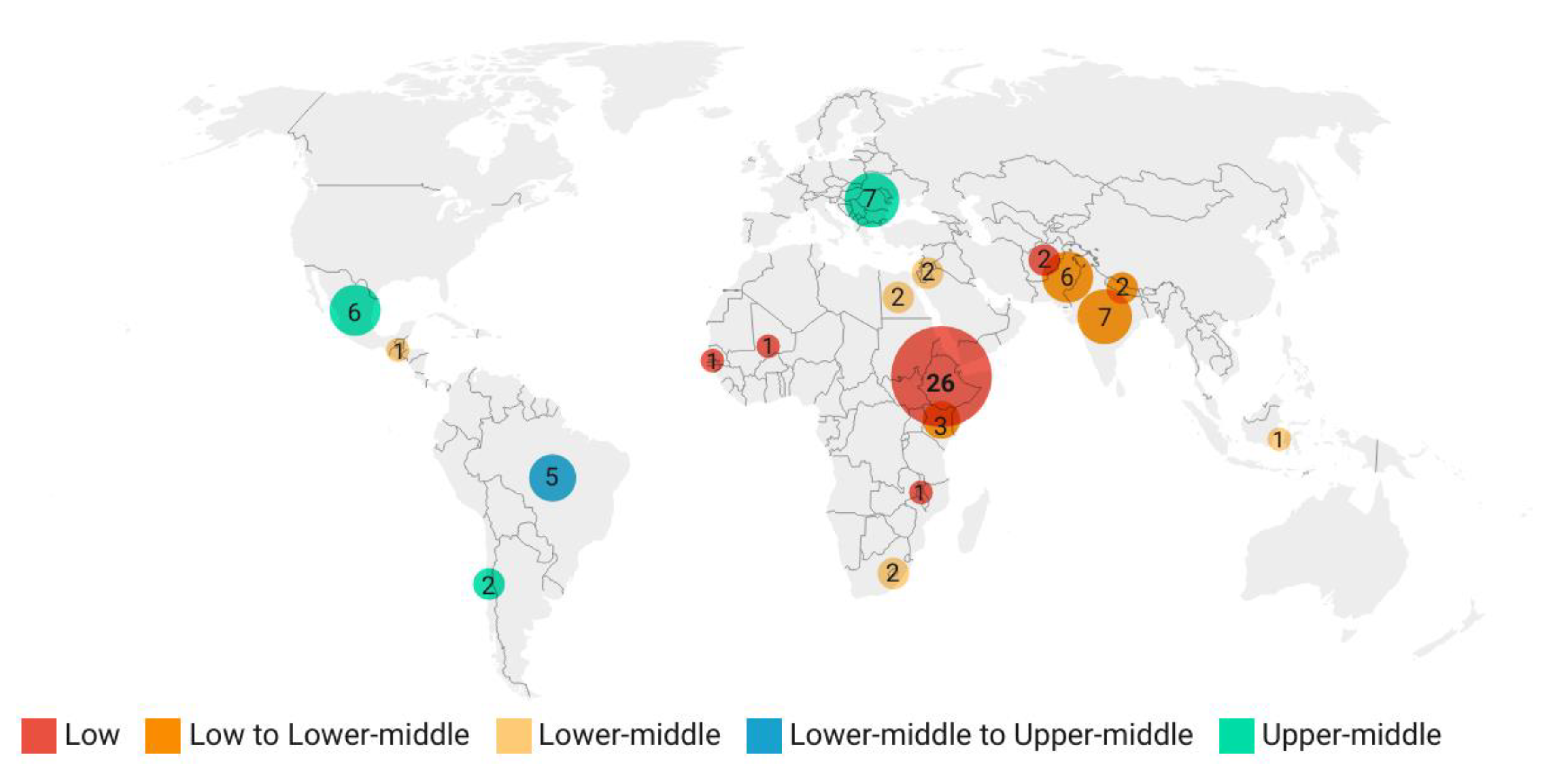
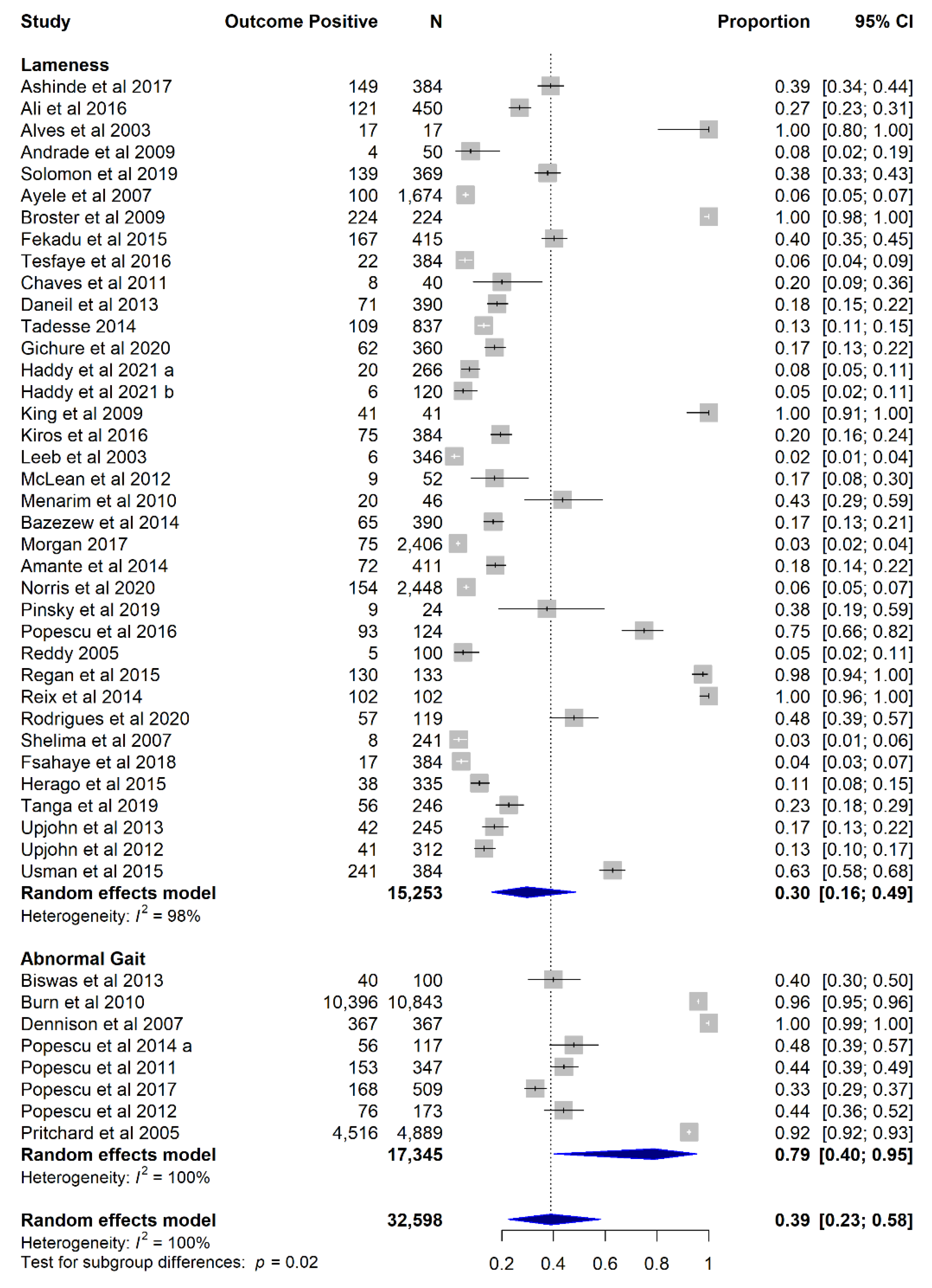
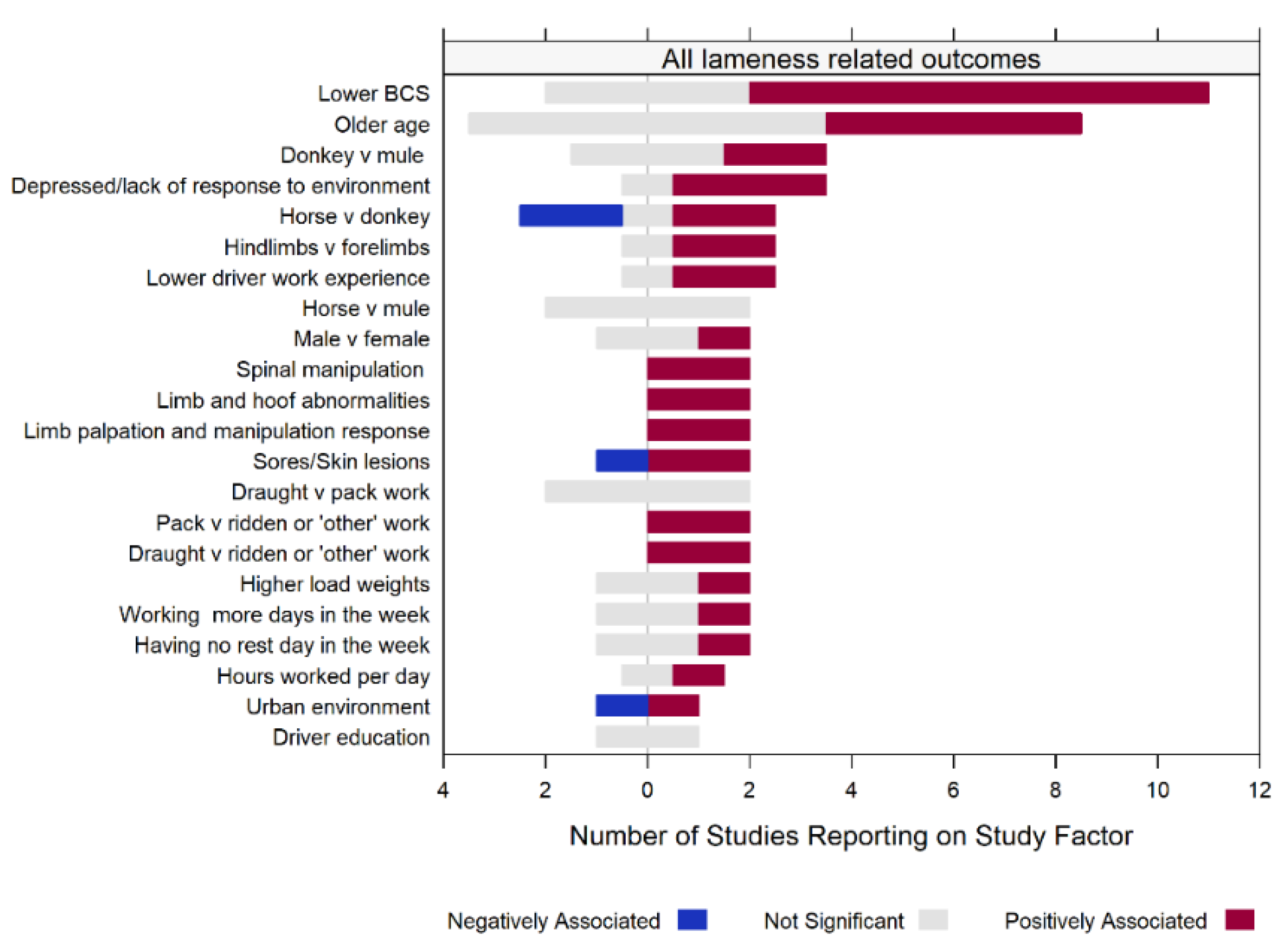
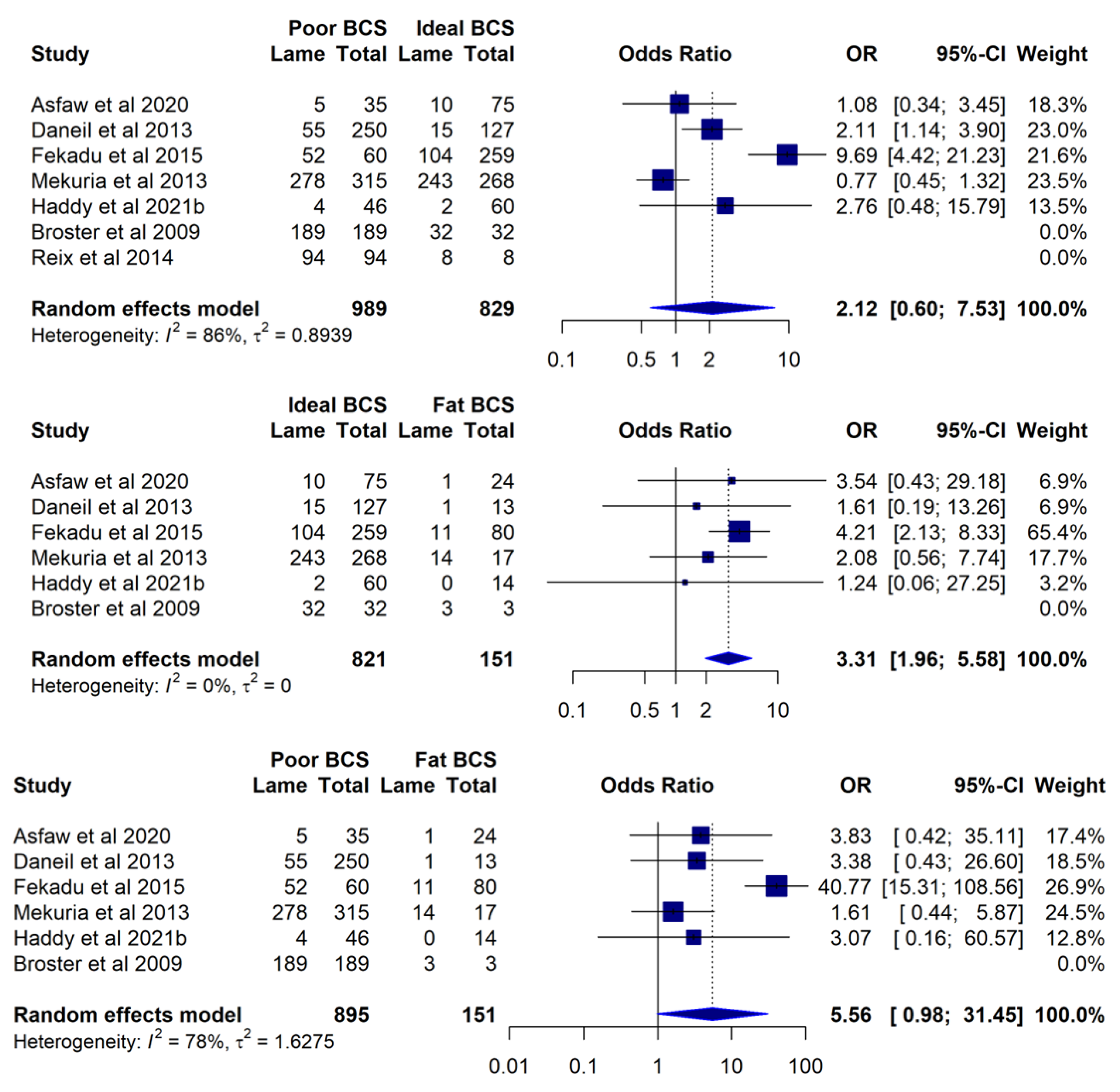

| Grading Scale Used | Number of Studies | |
|---|---|---|
| Unknown | 21 | 39.6% |
| Normal/Abnormal | 7 | 13.2% |
| 1–5 AAEP lameness scale [40] | 4 | 7.5% |
| Modified AAEP lameness scale | 2 | 3.8% |
| 1–5 Hands on donkey tool [41] | 3 | 5.7% |
| 1–5 (unspecified) | 2 | 3.8% |
| EARS tool [42] | 4 | 7.5% |
| Modified Busschers and Van Weeren (0–4) [43] | 1 | 1.9% |
| 0–10 (unspecified) | 1 | 1.9% |
| 0–2 (unspecified) | 1 | 1.9% |
| 0–3 (unspecified) | 1 | 1.9% |
| 0–5 (unspecified) | 1 | 1.9% |
| Mild, severe | 1 | 1.9% |
| Low, moderate, high | 1 | 1.9% |
| Low, moderate, high, immobile | 3 | 5.7% |
Publisher’s Note: MDPI stays neutral with regard to jurisdictional claims in published maps and institutional affiliations. |
© 2022 by the authors. Licensee MDPI, Basel, Switzerland. This article is an open access article distributed under the terms and conditions of the Creative Commons Attribution (CC BY) license (https://creativecommons.org/licenses/by/4.0/).
Share and Cite
Merridale-Punter, M.S.; Wiethoelter, A.K.; El-Hage, C.M.; Hitchens, P.L. Prevalence and Factors Associated with Working Equid Lameness in Low- and Middle-Income Countries: A Systematic Review and Meta-Analysis. Animals 2022, 12, 3100. https://doi.org/10.3390/ani12223100
Merridale-Punter MS, Wiethoelter AK, El-Hage CM, Hitchens PL. Prevalence and Factors Associated with Working Equid Lameness in Low- and Middle-Income Countries: A Systematic Review and Meta-Analysis. Animals. 2022; 12(22):3100. https://doi.org/10.3390/ani12223100
Chicago/Turabian StyleMerridale-Punter, Mathilde S., Anke K. Wiethoelter, Charles M. El-Hage, and Peta L. Hitchens. 2022. "Prevalence and Factors Associated with Working Equid Lameness in Low- and Middle-Income Countries: A Systematic Review and Meta-Analysis" Animals 12, no. 22: 3100. https://doi.org/10.3390/ani12223100
APA StyleMerridale-Punter, M. S., Wiethoelter, A. K., El-Hage, C. M., & Hitchens, P. L. (2022). Prevalence and Factors Associated with Working Equid Lameness in Low- and Middle-Income Countries: A Systematic Review and Meta-Analysis. Animals, 12(22), 3100. https://doi.org/10.3390/ani12223100






